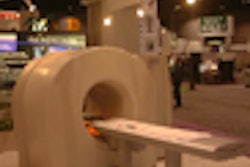Researchers who used a new radiopharmaceutical called DMP-444 to test for deep venous thrombosis declared it a success; another group found ventilation-perfusion scanning superior to electron beam CT for detecting pulmonary embolism.
Dr. Bryson Borg from Pennsylvania State College in Hershey presented his study at the Society of Nuclear Medicine meeting in June. The goal was to find a safe and effective test for detecting deep venous thrombosis (DVT) after total knee arthroplasty (TKA), Borg said. Current techniques, such as ascending venography and compression ultrasound, do not always have the best sensitivity and predictive value, he noted. DMP-444 is being developed by DuPont Pharmaceuticals of North Billerica, MA.
In Borg's study sample, 20 patients underwent either bilateral or unilateral TKA and were given warfarin prophylaxis, an anticoagulant. On the fourth or fifth day after the operation, each patient received an injection of 925 MBq of DMP-444, an investigational radiolabeled ligand. Images were obtained immediately after the injection, one hour later, and again at four hours. All but one of the patients also underwent compression ultrasound or venography, which was considered the gold-standard DVT test, Borg said.
According to the results of a per-patient analysis, DVT was found in 58% of all patients. DMP-444 had a 91% sensitivity, compared to ultrasound at 27%. Sonography fell particularly short at detecting DVT in the calf, which occurred in 47% of the patients, Borg said. However, ultrasound had a higher specificity at 100%, while DMP-444 had a specificity of 75%.
Dr. Mark Tulchinsky, one of Borg's co-authors and a moderator for the SNM session on pulmonary thromboembolism, added that DMP-444 scanning could be particularly useful in planning postoperative treatment. If a DMP-444 scan rules out DVT, the patient may not have to take anticoagulant drugs that can put the prosthesis at risk.
In a second presentation, a researcher from the University Hospital Charité in Berlin, Germany compared electron beam CT to lung scintigraphy for the diagnosis of pulmonary embolism.
"The diagnosis of pulmonary embolism has been an ongoing challenge for clinicians, radiologists, and nuclear medicine physicians. The ventilation-perfusion scan has been the first noninvasive step for exclusion of PE for a long time," said Dr. Beatrice Kettner. But V/Q scans have limited specificity, she said.
"Recently, contrast-agent enhanced CT was found to be useful for diagnosing PE, but conventional CT takes a long time for scanning the whole thoracic region," Kettner said. "Electron beam CT has two advantages: It's fast, with a scan time of about seven seconds, and it has a higher spatial resolution."
In this study, 38 patients who were suspected of having pulmonary embolism underwent both electron beam CT and lung scintigraphy. Agreement between the two modalities occurred in 84% of cases, or 32 patients. In 37% of the patients, the diagnosis of segmental or subsegmental PE was confirmed by both techniques, and ruled out in 47% of the cases.
Discrepancies were found in six, or 16%, of the patients, Kettner said. PE was found by lung scintigraphy in five patients, but the electron beam CT scan did not produce similar results. In one case, the patient required an angiography study to confirm PE.
While these results are promising, the lack of concordance between the two methods for finding segmental and subsegmental PE is still too low, Kettner said. More extensive research is necessary, in particular a prospective, randomized study comparing electron beam CT or spiral CT and ventilation-perfusion scans, she concluded.
By Shalmali Pal
AuntMinnie.com staff writer
June 21, 2000
Let AuntMinnie.com know what you think about this story.
Copyright © 2000 AuntMinnie.com




















